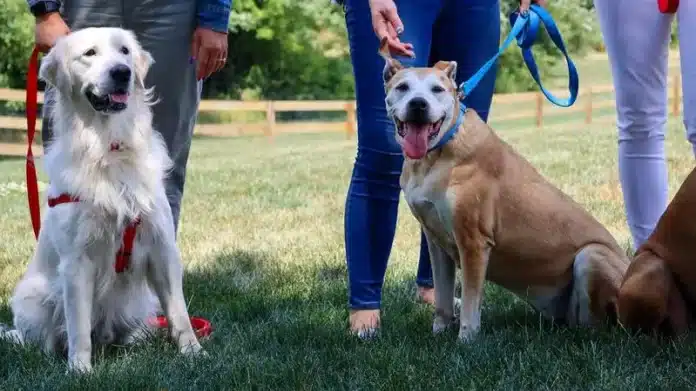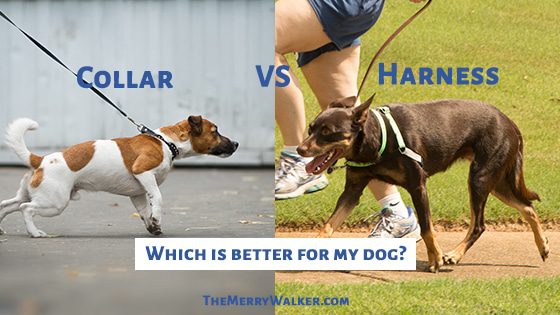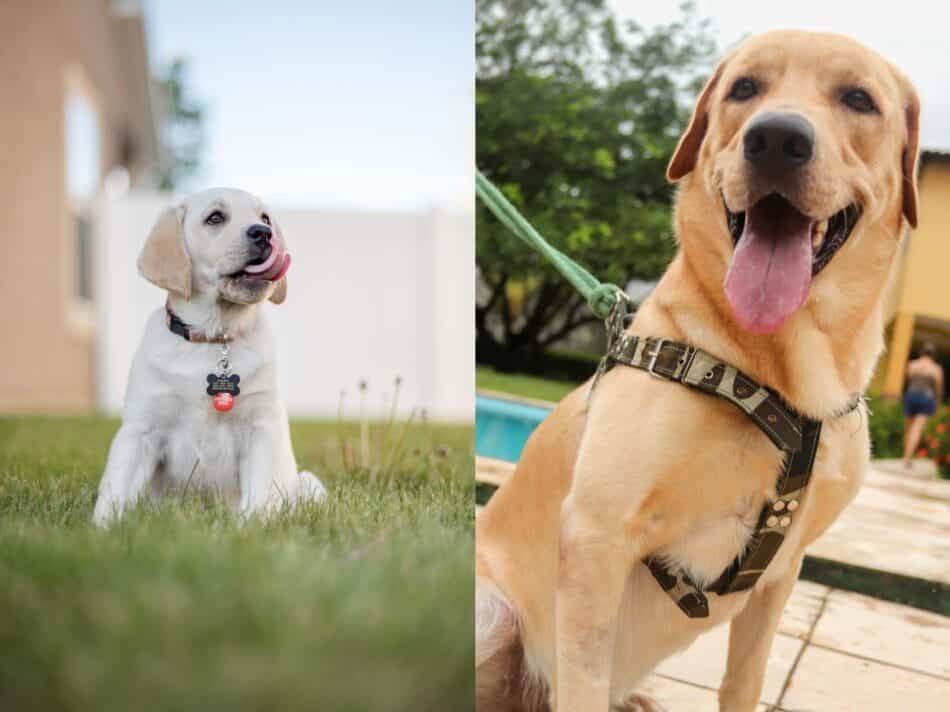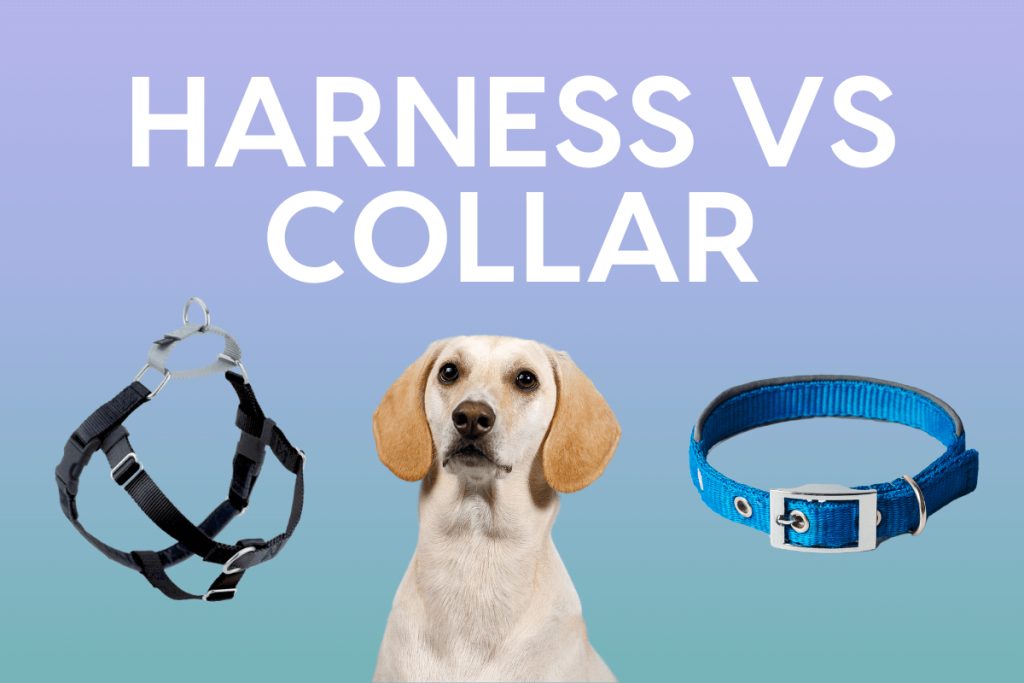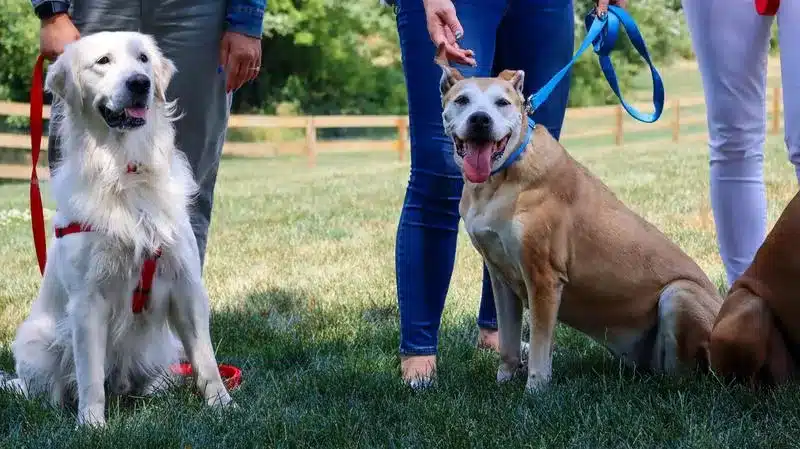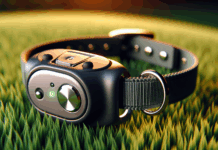Curious about the best method to train your furry companion? Look no further! In this article, we explore the age-old debate of whether training with a harness or a collar is more beneficial. We’ll discuss the pros and cons of each option, taking into consideration factors such as comfort, control, and overall safety.
Whether you have a naughty puppy or a seasoned adult dog, we’ve covered you with all the information you need to make an informed decision.
So, grab a treat and prepare to embark on this exciting journey of learning and understanding the best training methods for your four-legged friend!
This image is the property of merrymacdogtraining.com.
Benefits of Training with a Harness
Distributed Pressure
When it comes to training our furry friends, using a harness offers several advantages. One of the main benefits is the distribution of pressure across the dog’s body. Unlike collars that exert pressure on the neck, a harness distributes the force evenly, reducing the risk of injury and discomfort. This is particularly important for dogs with delicate windpipes or those prone to respiratory issues.
Better Control
Training with a harness gives us better control over our dogs’ movements. The design of a harness allows us to attach the leash to the back or front, enabling us to guide and redirect them more effectively. This can be especially useful for dogs that tend to pull or lunge, as it gives us greater leverage to manage their behavior. We can gently guide them back on track with a harness without causing harm or discomfort.
Reduced Risk of Neck Injury
Using a collar during training sessions can pose a risk of neck injuries, especially if our dogs tend to pull forcefully. By opting for a harness, we minimize the strain on their necks and reduce the chances of causing any long-term damage. This is particularly crucial for dogs with neck or spinal issues, as a harness provides much-needed support and protection.
Ideal for Small Breeds
For small dog breeds, training with a harness is often a better choice than using a collar. Their delicate necks and tracheas are particularly vulnerable, and the gentle distribution of pressure provided by a harness minimizes the likelihood of injury. Additionally, small dogs often have a tendency to pull more, partly due to their high energy levels. A harness makes it easier to manage their pulling and reduces the risk of accidental harm.
Supportive for Older or Injured Dogs
As our furry companions age or recover from injuries, they may require extra support during training sessions. A harness is an excellent choice in such cases, as it provides stability and minimizes the strain on their bodies. By distributing pressure evenly, the harness helps to alleviate any discomfort and allows older or injured dogs to engage in training activities without exacerbating their condition.
Considerations for Training with a Harness
Potential Chafing or Rubbing
While a harness can offer numerous benefits, it is vital to consider the potential for chafing or rubbing. Some dogs may be more prone to skin irritation, especially if the harness is not properly fitted or adjusted. Regular inspections and ensuring a good fit will help prevent any discomfort or injury. Also, choosing a soft, durable, and breathable harness can further minimize the risk of chafing.
Introductions and Familiarization
Before jumping into training with a harness, it is essential to introduce and familiarize our dogs with this new piece of equipment. Dogs can sometimes exhibit initial resistance or discomfort when wearing a harness, mainly if they are not accustomed to it. To help them adjust, we can start by simply allowing them to wear the harness for short periods indoors, gradually increasing the duration as they become more comfortable. Positive reinforcement, such as treats and praise, can also enhance their association with the harness.
Proper Fit and Adjustment
To ensure that our dogs reap the full benefits of training with a harness, choosing the right size and adjusting it is crucial. A poorly fitted harness can lead to discomfort, restriction of movement, or even accidental escape. Taking accurate measurements of our dogs’ chest and neck circumference will help us find the right size. Additionally, understanding the specific adjustment mechanisms of the chosen harness type is essential for achieving a secure and comfortable fit.
Choosing the Right Type of Harness
With various types of harnesses available, selecting the one that suits our dogs’ needs and training goals is essential. Some common types include step-in harnesses, back-clip harnesses, front-clip harnesses, tightening harnesses, and no-pull harnesses. Each type has its own unique features and benefits, allowing us to tailor the training experience to our dogs’ specific requirements.
Carefully considering our dogs’ size, breed, behavior, and any specific challenges they may have will help us make the best choice.
Advantages of Training with a Collar
Quick Response
Using a collar for training purposes offers several advantages. One significant benefit is the quick response it allows us to achieve. By having direct control over our dogs’ head movements, we can provide immediate feedback and quickly redirect their attention or behavior. This can be particularly effective when teaching them basic obedience commands or correcting certain behaviors.
Easier Identification
Collars, especially those with ID tags, serve as a quick and easy way to identify our dogs. In case they accidentally wander off or get lost, the collar can provide the necessary information for their safe return. This aspect of collar training adds an extra layer of security, ensuring that our furry companions can be identified and reunited with us swiftly.
Useful for Verbal Commands
Verbal commands play a crucial role in dog training, and collars can enhance the effectiveness of such commands. We can use gentle pressure or slight corrections to reinforce our verbal cues with a collar. This helps our dogs associate the command with the desired action and improves their response to our instructions.
Minimal Restrictions
Unlike harnesses, collars do not cover many of our dogs’ bodies, allowing them greater freedom of movement. This can be particularly beneficial during certain types of training, such as agility or sports activities. Collars offer the least amount of restriction and interference, enabling our dogs to perform at their full potential while still maintaining control.
Factors to Consider when Training with a Collar
Risk of Neck Injuries
While collars have their advantages, they also carry the risk of potential neck injuries. When dogs pull excessively, the pressure exerted on their necks can lead to neck strains, tracheal damage, or even more severe injuries. It is crucial to be mindful of our dogs’ behavior and the force we exert when using a collar during training. Ensuring the collar is properly adjusted and used correctly can help minimize the risk of injury.
Ensuring Correct Fit
The correct fit of a collar is paramount to both the effectiveness of training and the safety of our dogs. A collar that is too tight can cause discomfort, difficulty breathing, or even choking, while a collar that is too loose may slip off or be easily pulled over the head. Measuring our dogs’ neck circumference accurately and choosing an appropriately sized collar will help achieve a secure and comfortable fit.
Gentle Training Techniques
When training with a collar, it is essential to prioritize gentle training techniques. Avoid exerting excessive force or using harsh corrections, as this can lead to fear, anxiety, or aggression in our dogs. By focusing on positive reinforcement and reward-based training methods, we can create a nurturing and enjoyable learning environment for both us and our dogs.
Avoiding Long-term Dependency
While collars can be helpful training tools, we should strive to progress beyond their reliance in the long run. Encouraging our dogs to respond to verbal cues and commands without the need for physical corrections or pressure is essential. Gradually transitioning away from collar-dependent training and encouraging more independent responses will help foster a deeper bond and understanding between us and our dogs.
This image is the property of blog.omlet.co.uk.
Different Types of Harnesses
Step-in Harness
Step-in harnesses are one of the most popular types and are designed for easy and quick use. As the name suggests, dogs can step into the harness, making it convenient for trainers and trainees. Step-in harnesses typically have adjustable straps around the chest and belly, providing a secure and comfortable fit.
Back-clip Harness
Back-clip harnesses have a D-ring located on the back of the dog, to which the leash can be attached. This design allows for a more natural walking motion and provides excellent control over our dogs. Back-clip harnesses are particularly suitable for dogs that do not pull excessively and are generally well-behaved.
Front-clip Harness
Front-clip harnesses feature a D-ring attachment on the chest area of the harness. This positioning helps redirect our dogs’ attention towards us, discouraging pulling and promoting loose leash walking. Front-clip harnesses are especially effective for dogs that tend to pull or have high energy levels, giving us more control and influence over their movements.
Tightening Harness
Tightening harnesses, known as no-pull harnesses with a cinching mechanism, provide additional control over forcefully pulling dogs. When the dog pulls, the harness tightens slightly, applying pressure to discourage the pulling behavior. It is crucial to use this type of harness correctly, without causing distress or discomfort, and to seek guidance from a professional trainer if needed.
No-pull Harness
No-pull harnesses, as the name suggests, are specifically designed to minimize pulling. They often feature a front-clip attachment point on the chest and have additional padding or reinforcement to distribute pressure evenly. No-pull harnesses can be an excellent option for dogs that need extra guidance in overcoming their pulling tendencies.
Popular Types of Collars
Flat Collar
Flat collars are the most common and basic type of collar. They consist of a simple strap with a buckle or snap closure. Flat collars are versatile, lightweight, and easy to use. They are suitable for dogs of all sizes and are often used for everyday wear and identification.
Martingale Collar
Martingale collars, limited-slip collars, were originally designed for sighthounds. Their loop design allows for a gentle tightening when the dog pulls, creating a secure fit without choking. Martingale collars can be an excellent choice for dogs with narrow heads, like Greyhounds or Whippets, as they prevent the collar from slipping off.
Prong Collar
Prong collars, also referred to as pinch collars, are controversial training tools that should be used with caution and under the guidance of a professional trainer. They consist of prongs that apply pressure to the dog’s neck. When used correctly, prong collars can provide quick feedback and correction. However, it is essential to ensure proper fit and use them as a last resort for dogs with persistent behavior issues.
Head Collar
Head collars, such as the popular Gentle Leader or Halti, utilize a similar concept to a horse’s halter. They have a strap that fits around the dog’s nose, reducing their ability to pull significantly. Head collars offer control over the dog’s head movements and can be helpful for dogs that have difficulty with loose leash walking or exhibit strong pulling tendencies.
Choke Collar
Choke collars, or slip collars, consist of a chain or nylon loop that tightens when the leash is pulled. While they may be effective for some dogs when used correctly, choke collars have the potential to cause injury, discomfort, and even more severe consequences. It is crucial to seek professional advice before utilizing this type of collar and ensure it is used carefully and cautiously.
This image is the property of pupford.b-cdn.net.
Choosing the Right Training Equipment
Consider Dog’s Temperament
When selecting training equipment, we must consider our dogs’ temperaments. Some dogs may be more sensitive or responsive to specific training tools. For example, a harness may be more suitable for dogs prone to anxiety or discomfort, while a collar may be better suited for those with a confident and calm disposition. Understanding our dogs’ personalities and preferences will help us choose the most appropriate equipment for their training needs.
Purpose of Training
The purpose of training plays a significant role in determining the most suitable equipment. Different training goals require different tools. For example, if we are working on loose leash walking, a front-clip harness or a head collar may be beneficial in redirecting our dogs’ attention and discouraging pulling. On the other hand, if we are focusing on verbal commands and off-leash training, a collar may provide more convenience and control.
Size and Breed
The size and breed of our dogs also influence the choice of training equipment. Breeds with delicate necks, such as Greyhounds or Bulldogs, may require a harness for added support and safety. Additionally, the size of the equipment must be appropriate for our dogs. Ill-fitting collars or harnesses can cause discomfort or injury, so it is crucial to measure accurately and choose the right size for our furry friends.
Consulting a Professional Trainer
When in doubt, seeking the advice and guidance of a professional dog trainer can significantly assist in selecting the right training equipment. Trainers have extensive knowledge and experience in working with different breeds and temperaments and can help identify the most suitable tools for specific training needs. They can also provide valuable insights and recommendations based on our dogs’ unique characteristics and behavior.
Focusing on Positive Reinforcement
Regardless of the equipment we choose, it is essential to prioritize positive reinforcement in our training methods. Positive reinforcement involves rewarding desirable behaviors with treats, praise, or play, which encourages our dogs to repeat those behaviors. By cultivating a positive and supportive training environment, we strengthen the bond between us and our dogs, making the learning process more enjoyable and effective.
Combining Harness and Collar Training
Using Both for Different Purposes
Harnesses and collars can serve different purposes during training, and utilizing both can further enhance the overall training experience. For example, a harness can be beneficial for loose leash walking, while a collar may be more practical for teaching basic obedience commands. By understanding each tool’s specific benefits, we can strategically use both to suit different training goals and situations.
Gradual Transition
If we decide to transition from using one training tool to another, it is essential to do so gradually and with patience. Abruptly switching from a collar to a harness, or vice versa, may confuse and frustrate our dogs. Gradually introducing and phasing in the new tool while phasing out the old one allows our dogs to adjust steadily and comfortably. This gradual transition minimizes stress and helps maintain Consistency in their training.
Situational Approach
Adopting a situational approach to training with a harness and a collar can be highly effective. Assessing the specific training scenario and our dogs’ current level of compliance can help us decide which tool to use. For activities that require more control and guidance, such as leash manners or training in distracting environments, a harness may be a better choice. Conversely, more straightforward exercises or verbal command training may require a collar.
This image is the property of www.thesprucepets.com.
Training Methods and Techniques
Positive Reinforcement
Positive reinforcement is a highly effective training method that rewards desired behaviors. Using treats, praise, or play as rewards, we can motivate our dogs to repeat behaviors we want to reinforce. Positive reinforcement creates a positive association with training, encourages our dogs to engage actively, and fosters a strong bond based on trust and cooperation.
Reward-based Training
Like positive reinforcement, reward-based training uses rewards to reinforce desired behaviors. However, rewards extend beyond treats and can include other forms of motivation, such as toys, verbal praise, or belly rubs. By identifying what motivates our dogs and using those rewards consistently, we can encourage them to excel in their training sessions.
Clicker Training
Clicker training involves using a handheld device that emits a distinct sound (such as a click) to mark desirable behavior. The sound is immediately followed by a reward, which helps the dog associate the sound with positive reinforcement. Clicker training efficiently shapes and captures precise behaviors, as the sound is a clear marker of success.
Voice Commands
Verbal commands play a vital role in training our dogs, and consistent verbal cues can help create clear communication between us and our furry friends. Using specific and consistent command words, such as “Sit,” “Stay,” or “Come,” helps our dogs understand what behavior is expected of them. Pairing these commands with positive reinforcement ensures that our dogs associate the words with positive outcomes.
Establishing Consistency
Consistency is vital in dog training. Dogs thrive in an environment where expectations and responses remain consistent. By using consistent training techniques, cues, and commands, we provide our dogs with clear guidance and reduce confusion. Consistency also helps reinforce learned behaviors, as repetition and practice build strong associations and habits.
Conclusion
Several factors must be considered when deciding between training with a harness or a collar. No one-size-fits-all answer exists, as each dog is unique and requires individualized training approaches. The decision should be based on the dog’s temperament, training goals, and any specific needs they may have. Regularly evaluating the training equipment and techniques is crucial to ensure our dogs’ safety, comfort, and overall well-being.
This image is the property of www.coastalpet.com.

